ECE Resource Centre: Demonstrating a Model Learning Environment
By Shankar K
Children are natural learners, especially, children between the ages of 3-8 years. They involve themselves in the learning process completely if ample opportunities are provided. This is why a stimulating learning environment is paramount for the learning and development of pre-primary children. During this critical phase of rapid brain development, children’s curiosity thrives in settings offering diverse sensory experiences and engaging activities. Such an environment fosters cognitive growth, problem-solving, and social-emotional skills. Language and communication abilities flourish through rich language exposure. A stimulating atmosphere encourages creativity and supports physical development; it builds confidence and fosters a positive attitude toward education.
The Concept of ECE Resource Centre
Early Childhood Education (ECE) Resource Centre is a physical setup which aims to demonstrate a developmentally appropriate learning space for pre-primary children. It acts as a centre for practising pedagogical interventions; a functional model of stimulating learning environment, material development and teaching-learning practices; and as a centre for the professional development of teachers. The idea of a resource centre is aligned with the guidelines and suggestions in the National Curriculum Framework-Foundational Stage (NCF-FS).
An ECE resource centre embraces the principles of early learning, systematically organising Learning Corners with appropriate materials to enrich child-centred learning experiences. Learning Corners, each with a unique focus and catering to specific learning levels which engage children and stimulate learning, play a key role in such a setup. Learning Corners are integral to play-based, child-centred early education, fostering meaningful experiences and knowledge construction.
A model ECE Resource Centre
The idea of setting up an ECE Resource Centre was proposed by the District Institute (DI), Azim Premji Foundation, Puducherry to Samagra Shiksha – Puducherry with the following objectives:
- To demonstrate a stimulative learning environment that facilitates developmentally appropriate practice at the Foundational Stage (3 to 6 years)
- To enable pre-primary teachers to understand the functional purpose of ECE infrastructural setup, interactional environment, and temporal environment for daily routine and organisation of the ECE class
- To facilitate pre-primary teachers’ access, participation and learning in a real-time environment
- To build the capacities of the DI team in their work of supporting teachers and other stakeholders in ECE
The guiding principles to operationalise this centre were as follows:
- Centre for practice: The Resource Centre was envisaged as a practising centre. All teachers and members would be engaged in teaching-learning practices and practice the curricular components.
- Maintain robust academic rigor: The Resource Centre would adhere to strong academic rigor to suggest the best curricular interventions, material development, teaching-learning practices, and professional development of teachers in the cluster.
- Functional model of a stimulative learning environment: The Resource Centre would showcase the organisation and management of an engaging learning environment functionally. This would include the display of thematic, print-rich, developmentally appropriate materials along with a demonstration of teaching ideas with simple and low- and no-cost materials.
- Demonstration of the temporal learning environment: The Resource Centre would demonstrate the time and space of the curricular activities, such as routines and transition of activities in a typical preschool day for the benefit of pre-primary teachers.
- Demonstration of interactional environment: The Resource Centre would demonstrate an interactional environment to allow children to interact with objects, peers, and adults and engage in shared sustained conversations facilitated by the centre resource teacher.
- Openness to new ideas: The Resource Centre would be open to new ideas, and should frequently try out and experiment with new methods of arriving at ECE and Foundational Stage developmental goals.
The Context
In 2006, the Government of Puducherry introduced pre-primary sections in primary and upper primary schools. Currently, 191 schools have LKG and UKG sections with 6000 (approx.) students in the district. The pre-primary sections became a part of mainstream primary education with adequate infrastructure and pre-primary faculties. The NEP 2020 and NCF-FS 2022 gave a thrust to ECE in Puducherry. Azim Premji Foundation’s role is significant in this journey.
The Directorate of School Education, Puducherry and Azim Premji Foundation, Puducherry, have collaboratively been taking many initiatives to ensure quality ECE in the Puducherry UT. In the ECE domain, Puducherry set an example for the whole nation through its dedicated pioneering efforts, such as the creation of the Pre-primary Teacher Handbook and Curriculum, LKG and UKG thematic activity books, continuous capacity-building of pre-primary teachers on developmental domains and thematic plans, establishing model ECE classrooms, and collaboration with NGO partners for ECE interventions among others.
Process of setting up the Resource Centre
The team at the District Institute (DI), Puducherry (Azim Premji Foundation) proposed the idea of an ECE Resource Centre and its importance in ECE with Samagra Shiksha – Puducherry. A concept note was submitted to the State Project Director, Samagra Shiksha. After a series of deliberations with the Director and other functionaries of the Department of Education, the order was issued for the setting up of an ECE Resource Centre in one of the government primary schools.
From the initial list of ten schools that the DI team visited and reviewed, Government Primary School, Thattanchavady was selected.
After the selection of the school, the DI team approached the school headmaster with the department order. A spare classroom was chosen for the centre to be set up in. The DI team requested the headmaster and teachers at that school to extend their support in this initiative and oriented them towards the objectives and importance of it.
After observing the classroom infrastructure and its measurement, the DI team drew an outline of the classroom and explored possible ways of setting up the various learning corners that would be child-friendly. Along with the inputs from the ECE Sangareddy DI team, we decided to set up a creative corner, literacy corner, numeracy corner, blocks corner and a dramatic play corner.
Traditional pre-primary classrooms were filled with alphabets and conventional pictures. For our ECE Resource Centre, we selected illustrations and graphics appropriate for the learning of preschool children. These were discussed in detail with the government Fine Art teachers, who volunteered to paint them.
On December 8, 2022, following the completion of the graphic painting and the setting up of the Learning Corners, the ECE Resource Centre was officially inaugurated by the Director of the Directorate of School Education, Puducherry. The event was attended by the Chief Educational Officer, the State Project Director for Samagra Shiksha, and other Inspecting Officers. The Director visited each Learning Corner and looked at the learning materials. The DI team explained the significance of each material in relation to developmental domains.
The DI team felt that it was crucial to orient and sensitise the functionaries and teachers at the school about the Centre and its importance in alignment with the NEP 2020. So, the team organised a half-day orientation for them in which the importance of a stimulating learning environment, the idea of learning corners, and the shared utilisation of the Centre were deliberated.
The parents’ community of the school came forward to support the outdoor unit establishment. Subsequently, Samagra Shiksha – Puducherry came forward to establish nine such resource centres in government school premises across Puducherry. In this way, this ECE Resource Centre supported effective practice-based teacher engagements, and appropriate children’s behaviours, like focussing, pairing, interactions, and other significant habit formation.
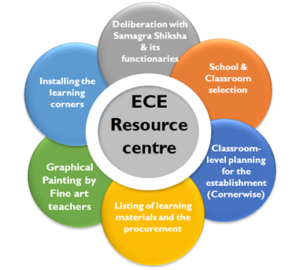
Operating mechanism – Shared and specific responsibility
- ECE Resource Centre is collaboratively managed by the Department of School Education and Azim Premji Foundation – District Institute Puducherry.
- A well-trained pre-primary teacher is responsible for managing the centre, under the mentorship of the DI team.
- Resource Persons of the DI team also practice ECE curricular interventions with children and teachers.
- Resource persons provide academic help, consultations and work together with teachers on all academic matters.
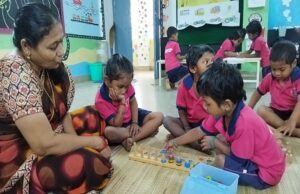
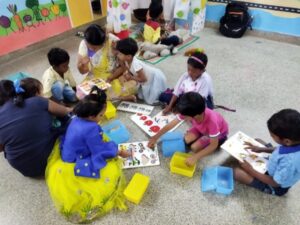
Government’s ownership
Samagra Shiksha – Puducherry decided to establish nine additional model resource centres in government school premises after witnessing the positive impact of the ECE Resource Centre at GPS Thattanchavady. The DI team provided assistance in several ways, such as selecting schools, generating graphic painting ideas, procuring materials, setting up learning corners, selecting and obtaining books, and supporting teachers. These resource centres became operational in the 2023-24 academic year. Each resource centre was mapped with a Resource Person to empower teachers and guarantee its optimal use and effectiveness.
Headmasters of the selected schools were given an orientation on NCF-FS and the importance of ECE. The purpose of an ECE resource centre was also explained and they were provided the opportunity to explore the learning materials and learning corners of the ECE Resource Centre, GPS Thattanchavady.
Head Teacher orientation
Glimpses of government-funded ECE Resource Centres
GPS Pettichetpet
GPS Ayyankuttipalayam
GPS Kombakkam
GPS Kirumampakkam
GPS Sedarapet
GPS Thiruvandarkoil
Impact on the ground
The establishment of the ECE Resource Centre, GPS Thattanchavady, has brought about a remarkable transformation. Through first-hand observations and feedback from both teachers and students, it is evident that this centre has significantly enhanced the learning environment for young children. For instance, in the Creative Corner, children are frequently seen enthusiastically expressing themselves through art, with their faces beaming with excitement as they proudly showcase their creations to their peers and teachers.
Students benefit from Learning Corners
There is a heartwarming story of a young student who was initially struggling with reading but, with the help of engaging materials provided in the Literacy Corner, made a breakthrough by pretend reading a storybook aloud to the class, sparking applause and a sense of achievement. Using the Numeracy Corner, students are not only learning mathematical concepts but are also developing problem-solving skills, as evidenced by the smiles of accomplishment on their faces when they successfully complete a challenging puzzle.
In the Dramatic Play Corner, children are actively involved in imaginative play scenarios, where they take on different roles and use their creativity to solve imaginary problems together. The laughter and teamwork seen here reflect the growth of social skills and emotional intelligence. This model Resource Centre has enriched teaching practices and enhanced students’ holistic learning experiences, reinforcing the importance of such a stimulative environment in ECE.
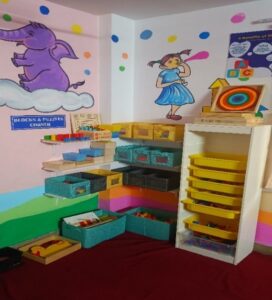
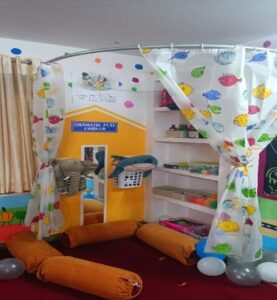
Students exploring and experiencing the learning corners.
Teacher professional development
As a part of continuous teacher professional development, 25 pre-primary teachers, mentored by the Resource Persons of the DI, gain valuable experience and expertise in managing the ECE resource centres in a continuous manner.
All pre-primary teachers will be taken to a nearby resource centre for exposure cum learning in the current academic year. The Government RPs will also be engaged in material development and enhancement of their professional skills. The resource centres will act as demonstration platforms where teachers learn from their peers.
The ECE Resource Centre, GPS Thattanchavady, serves as the learning arm of the Puducherry – District Institute, fostering continuous capacity building through experiential learning.
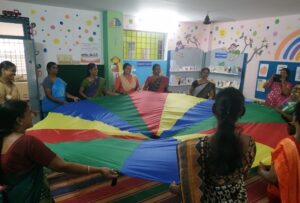
Teacher engagement at ECE Resource Centre
Promoting alignment with NEP
The orientation sessions for teachers emphasise the importance of a stimulating learning environment, learning corners, and shared utilization of the resource centre, guidelines and principles aligned with the NEP 2020’s principles for ECE and the mandate of NCF-FS. This also helps the teachers to understand these policy documents and their implementation on the ground.
Educational ownership
Through an orientation on NCF-FS and the importance of ECE, the resource centre initiative has garnered support from school headmasters. They have been briefed about the purpose of the ECE resource centre and its learning materials and corners. The presence of such resource centres improves the reputation and increases enrolment in government schools. For example, at GPS Thattanchavady, the SMC came forward to sponsor the outdoor unit which is part of the ECE Resource Centre.
Conclusion
The success of this initiative is largely a result of the remarkable collaboration and support it garnered. Conversations with key stakeholders, such as the functionaries of the Department of School Education, the headmaster, and dedicated teachers, reveal their unwavering commitment to this transformative project. For instance, during a recent meeting with the headmaster, he shared his excitement about the Resource Centre’s positive impact, highlighting how it has reinvigorated the school environment. He proudly mentioned that students now eagerly rush to the Learning Corners and engage in various activities that complement their regular curriculum.
Teachers shared how they have integrated the centre’s materials into their teaching strategies. One teacher mentioned how the Numeracy Corner has become a hub for interactive math lessons, making abstract concepts tangible and enjoyable for students. Teachers enthusiastically collaborate to ensure that each Learning Corner is properly maintained, and materials are readily accessible to enrich their students’ educational experience.
Perhaps the most encouraging news is that this successful model has inspired the Samagra Shiksha, Puducherry, to establish 50 more similar centres in the academic year (2023-24) across all districts of Puducherry. This decision is a clear endorsement of the positive outcomes and impacts observed in the initial stages of this initiative, reflecting the commitment of educational authorities to provide quality learning experiences to young children in the region.
References
National Education Policy (NEP) 2020 https://www.education.gov.in/sites/upload_files/mhrd/files/NEP_Final_English_0.pdf –
National Curriculum Framework – Foundational stage 2022 https://ncert.nic.in/pdf/NCF_for_Foundational_Stage_20_October_2022.pdf
Play and Learning Environment https://www.sagepub.com/sites/default/files/upm-binaries/53567_ch_10.pdf
AUTHOR
Shankar K is Block Coordinator, District Institute, Azim Premji Foundation, Puducherry

